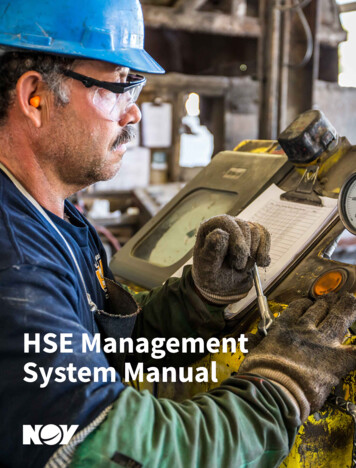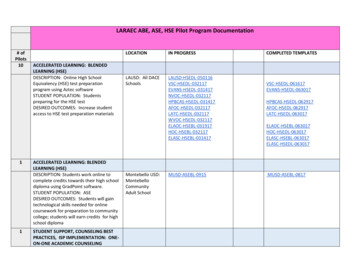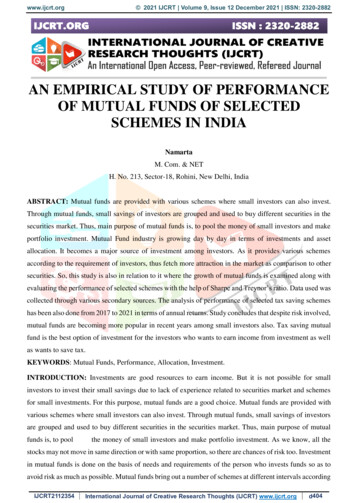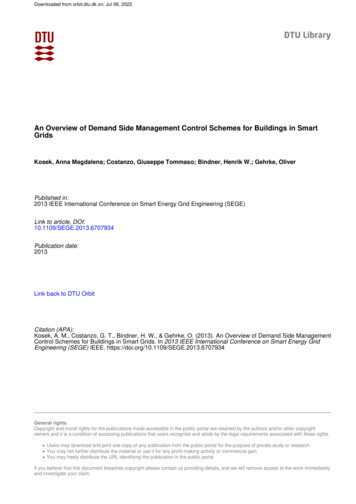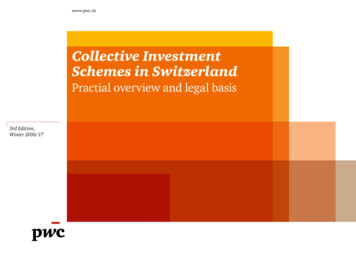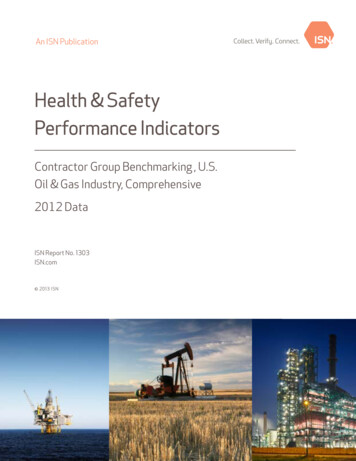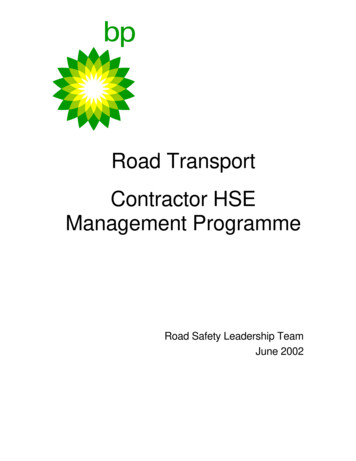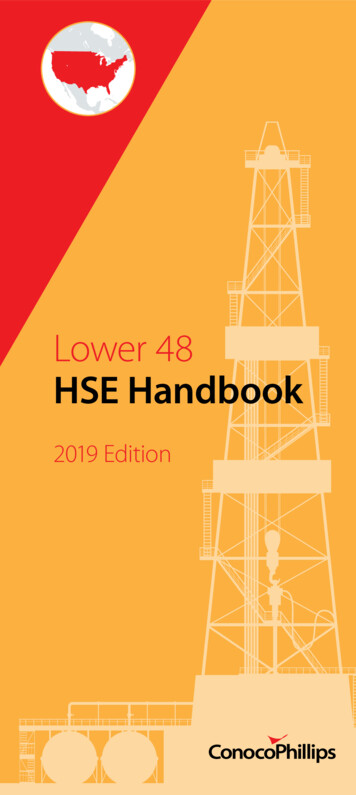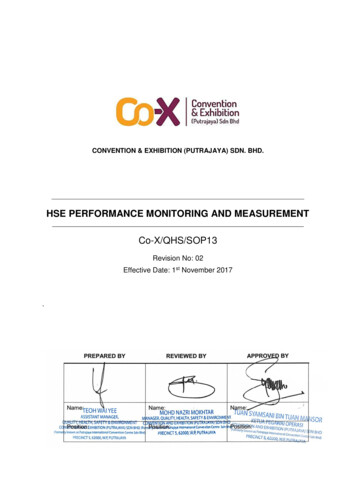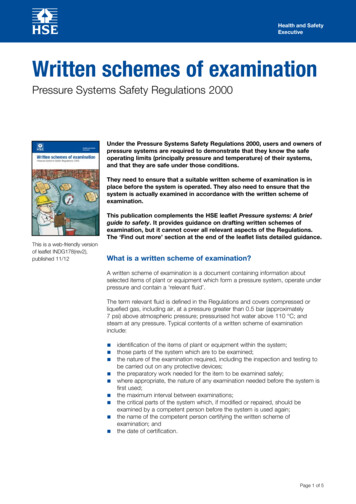
Transcription
Health and SafetyExecutiveWritten schemes of examinationPressure Systems Safety Regulations 2000Under the Pressure Systems Safety Regulations 2000, users and owners ofpressure systems are required to demonstrate that they know the safeoperating limits (principally pressure and temperature) of their systems,and that they are safe under those conditions.They need to ensure that a suitable written scheme of examination is inplace before the system is operated. They also need to ensure that thesystem is actually examined in accordance with the written scheme ofexamination.This publication complements the HSE leaflet Pressure systems: A briefguide to safety. It provides guidance on drafting written schemes ofexamination, but it cannot cover all relevant aspects of the Regulations.The ‘Find out more’ section at the end of the leaflet lists detailed guidance.This is a web-friendly versionof leaflet INDG178(rev2),published 11/12What is a written scheme of examination?A written scheme of examination is a document containing information aboutselected items of plant or equipment which form a pressure system, operate underpressure and contain a ‘relevant fluid’.The term relevant fluid is defined in the Regulations and covers compressed orliquefied gas, including air, at a pressure greater than 0.5 bar (approximately7 psi) above atmospheric pressure; pressurised hot water above 110 C; andsteam at any pressure. Typical contents of a written scheme of examinationinclude: identification of the items of plant or equipment within the system; those parts of the system which are to be examined; the nature of the examination required, including the inspection and testing to be carried out on any protective devices;the preparatory work needed for the item to be examined safely;where appropriate, the nature of any examination needed before the system isfirst used;the maximum interval between examinations;the critical parts of the system which, if modified or repaired, should beexamined by a competent person before the system is used again;the name of the competent person certifying the written scheme ofexamination; andthe date of certification.Page 1 of 5
Health and SafetyExecutiveHow do I draw up a written scheme of examination?First, look around your workplace and decide which items of plant or equipmentoperate under pressure and form a pressure system.Next, follow the steps described in the HSE leaflet Pressure systems: A brief guideto safety (see the ‘Find out more’ section at the end of the leaflet).Then check the exceptions to the Regulations, as you may find your particularpressure system does not require a written scheme of examination at all. Forexample, you don’t normally need to include the compressor associated with an airreceiver in the scheme of examination.To see if any of your plant or equipment is an exception under the Regulations, thebest place to look first is Safety of pressure systems. Pressure Systems SafetyRegulations 2000. Approved Code of Practice (see ‘Find out more’ for details).Which items of plant should I include in the written scheme ofexamination?An item of plant from the pressure system should be included in a written schemeof examination if its failure could unintentionally release pressure from the systemand the resulting release of stored energy could cause injury.Each system is likely to be unique, but the following questions may help users toarrive at some decisions: Do the manufacturers of the plant or equipment forming the pressure system give guidance, instruction and the precautions to take for safe operation of the system?Could failure of any part of the pressure system cause someone in the vicinityto be injured by the release of pressure, fragments or steam?Does the pressure system contain any protective devices?If the answer to any of these questions is ‘Yes’, then those items of plant may needto be included in the written scheme of examination.What types of typical pressurised systems might require awritten scheme of examination?The following pressurised systems are likely to require a written scheme ofexamination: a compressed air receiver and the associated pipework, where the product of the pressure in bars multiplied by the internal capacity in litres of the receiver isequal to or greater than 250 bar litres;a steam sterilising autoclave and associated pipework and protective devices;a steam boiler and associated pipework and protective devices;a pressure cooker;a gas-loaded hydraulic accumulator;a vapour compression refrigeration system where the installed power exceeds25 kW;a narrow-gauge steam locomotive;the components of self-contained breathing apparatus sets (excluding the gascontainer); anda fixed liquefied petroleum gas (LPG) storage system, supplying fuel for heatingin a workplace.Written schemes of examination: Pressure Systems Safety Regulations 2000Page 2 of 5
Health and SafetyExecutiveThe following pressurised systems are exempted from the Regulations and will notrequire a written scheme of examination: a machine tool hydraulic system; any pipeline and its protective devices in which the pressure does not exceed 2 bar above atmospheric pressure;a portable fire extinguisher with a working pressure below 25 bar at 60 C andhaving a total mass of no more than 23 kg; anda tyre used on a vehicle.The following pressurised systems are not likely to require a written scheme ofexamination: an office hot water urn (for making tea etc);a pneumatic cylinder in a compressed air system;a handheld tool;a combustion engine cooling system;a portable compressed air receiver and the associated pipework, where theproduct of the pressure in bars multiplied by the internal capacity in litres of thereceiver is less than 250 bar litres; anda portable LPG cylinder.These are typical examples for guidance purposes only. You must decide whetheryour pressurised system is covered by the Regulations in practice.Do I need written schemes of examination for portable gaswelding sets?A written scheme of examination is not required for the following: regulators;pressure gauges;hoses;torches; andother components that form part of conventional gas welding sets (portable,twin cylinder, oxyacetylene or oxypropane sets used for welding, cutting andburning).Who decides which items of plant are included in the writtenscheme of examination?Users of pressure equipment which is not mobile, or owners of mobile systems(eg hired pressure plant), have a legal responsibility to define the items of plant thatform a pressure system and, within that system, the items of plant which need tobe included in the written scheme of examination.To arrive at a properly informed decision, users or owners may need to seek advicefrom other sources, such as in-house engineering staff, inspection bodies orconsultants, but the legal responsibility for defining the scope of the scheme restswith users or owners.The written scheme should generally cover all items within a self-containedpressurised system which may give rise to danger. If you have more than one selfcontained pressure system, you will probably need more than one written scheme,ie one system, one scheme.Written schemes of examination: Pressure Systems Safety Regulations 2000Page 3 of 5
Health and SafetyExecutiveWhat happens when the scope of the written scheme has beendecided?The user or owner of the pressure system should: contact a person with sufficient knowledge and expertise about the system, ie one who is capable of offering informed advice on the subject;discuss the scope of the written scheme with them; andif necessary, modify the scope accordingly.The written scheme of examination should then be submitted to a competentperson (as defined in the Regulations), who may or may not be the samecompetent person who advised the user or owner on the scope of the writtenscheme.The competent person will normally advise on the nature and frequency ofexamination and any special safety measures necessary to prepare the system forexamination. If requested by the user, the competent person may draw up asuitable written scheme of examination, or they may certify a written scheme ofexamination, prepared by the user or owner, as being suitable.Which competent person should I choose?Guidance on the selection of competent persons is given in the HSE publicationsPressure systems: A brief guide to safety and Safety of pressure systems. PressureSystems Safety Regulations 2000. Approved Code of Practice(see ‘Find out more’ at the end of this leaflet).Users (or owners) of pressure systems are free to select any competent person, butthey should take all reasonable steps to ensure that the person selected canactually demonstrate competence, ie the necessary breadth of knowledge,experience and independence.To help users or owners judge levels of competence, a national accreditationscheme has been developed by the United Kingdom Accreditation Service (UKAS)for bodies that provide such services. Further details are given in ‘Find out more’.Does the written scheme of examination need to be reviewedperiodically?It must be ‘suitable’ throughout the lifetime of the plant or equipment, so it shouldbe reviewed and, when necessary, revised. For example, as the age of some plantincreases you may need to carry out more frequent examinations or change theircontent or type.It is the user’s responsibility under the Regulations to ensure the content of thewritten scheme is reviewed at appropriate intervals by a competent person todetermine whether it remains suitable, but clearly the competent person should bein a position to give advice on this aspect.What should I do next?The users and owners of pressure systems covered by a written scheme ofexamination have a legal responsibility to ensure that those systems are examinedby a competent person in accordance with the scheme.Written schemes of examination: Pressure Systems Safety Regulations 2000Page 4 of 5
Health and SafetyExecutiveFind out moreSafety of pressure systems. Pressure Systems Safety Regulations 2000.Approved Code of Practice L122 HSE Books 2000 ISBN 978 0 7176 1767 8www.hse.gov.uk/pubns/books/l122.htmPressure systems at work: A brief guide to safety Leaflet INDG261(rev2)HSE Books 2012 www.hse.gov.uk/pubns/indg261.htmThe Pressure Systems Safety Regulations 2000 SI 2000/128The Stationery Office 2000 ISBN 978 0 11 085836 4The Stationery Office publicationsAvailable from The Stationery Office, PO Box 29, Norwich NR3 1GNTel: 0870 600 5522 Fax: 0870 600 5533 email: customer.services@tso.co.ukWebsite: www.tsoshop.co.uk/ (They are also available from bookshops.) StatutoryInstruments can be viewed free of charge at www.legislation.gov.uk/.UKASFor advice on bodies with relevant accreditation for providing competent persons:UKAS, 2147 High Street, Feltham, Middlesex, TW13 4UN Tel: 020 8917 8400Website: www.ukas.comFurther informationFor information about health and safety, or to report inconsistencies or inaccuraciesin this guidance, visit www.hse.gov.uk/. You can view HSE guidance online andorder priced publications from the website. HSE priced publications are alsoavailable from bookshops.This guidance is issued by the Health and Safety Executive. Following the guidanceis not compulsory, unless specifically stated, and you are free to take other action.But if you do follow the guidance you will normally be doing enough to comply withthe law. Health and safety inspectors seek to secure compliance with the law andmay refer to this guidance.This leaflet is available at: www.hse.gov.uk/pubns/indg178.htm. Crown copyright If you wish to reuse this information visitwww.hse.gov.uk/copyright.htm for details. First published 11/12.Published by the Health and Safety Executive11/12INDG178(rev2)Page 5 of 5
the date of certification. Health and Safety Executive Written schemes of examination: Pressure Systems Safety Regulations 2000 Page 2 of 5 . inspection bodies or consultants, but the legal responsibility for defining the scope of the scheme rests with users or owners. The written scheme should generally cover all items within a self-contained
